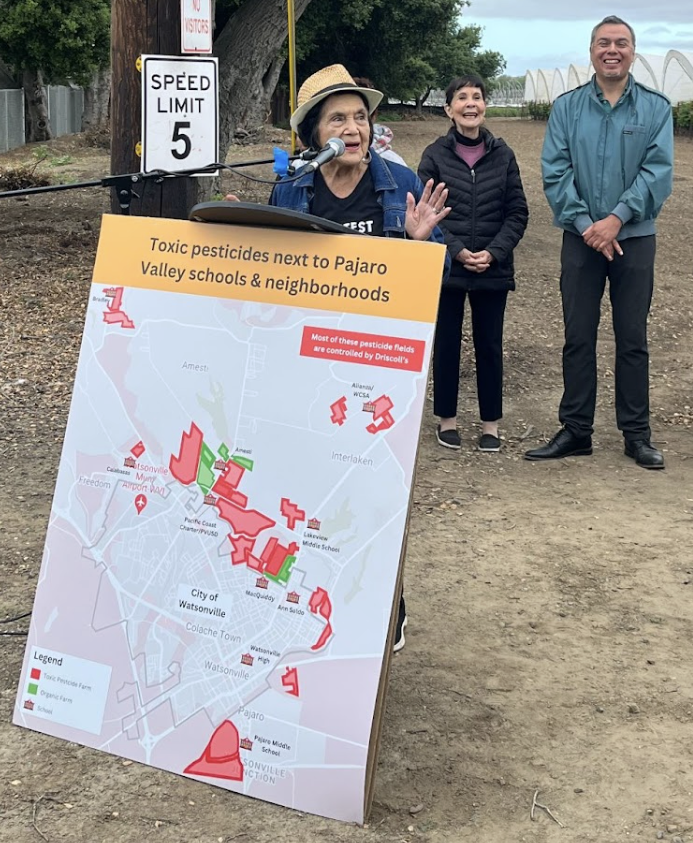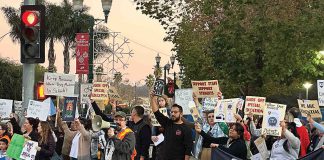
Prominent farmworker activist and organizer Dolores Huerta joined several other speakers at a public meeting in Watsonville Saturday to raise awareness about the dangers of agricultural pesticide use on farmworkers, children, consumers and residents throughout Santa Cruz county.
Childhood cancer rates in Santa Cruz county are more than 38% above the overall childhood cancer rate of 16.3%. This makes the cancer rate for children 0 to 14 years old the second highest in Santa Cruz county of all California counties, according to Dr. Ann López, the director of the Center for Farmworker Families.
The meeting was organized by the Campaign for Organic and Regenerative Agriculture (CORA).
On the CORA’s website, they state that over 1 million pounds of pesticides are used in Santa Cruz county each year. The majority of this usage is concentrated in the Pajaro Valley, often near houses and schools.
López said that “98.5% of the pesticides associated with childhood leukemia and 95.2% of pesticides tied to childhood brain cancer were applied in 2019 in this zip code [95076] alone.”
The zip code 95076 encompasses all of Watsonville.
Huerta urged the community to stop buying berries grown by Driscoll’s because much of their produce is sprayed with toxic pesticides.
She also said that Driscoll’s won’t let their farm workers unionize, and as a result, they aren’t able to improve their working conditions.
“The one thing about having a union contract is [that] when you sit down at the table to negotiate, you can say to them, ‘We don’t want you to use pesticides.’ You can make that a condition of the work.”
Among the speakers was Marciela Cruz, who was diagnosed with stomach cancer after working in strawberry fields in Salinas. She said she had undergone eight chemotherapy sessions and had to have her entire stomach removed. Her doctor told her the cancer may have been caused by her exposure to toxic pesticides sprayed in the fields.
Mireya Gómez-Contreras, the administrative co-leader of Esperanza Community Farms, interpreted for Cruz.
Regarding the non-organic field behind MacQuiddy Elementary, Gómez-Contreras, on Cruz’s behalf, said that if Cruz could speak to the rancher who owned that farm, she’d tell them “to get rid of the ranch or to turn it organic because the pesticides are affecting all of the farm workers.”
According to López, Monterey county–compared to every other county in the state–has a higher percentage of schools and students in areas with the greatest pesticide use, affecting 29 schools and 18,525 students.
She said that the lifetime cancer risk at Ohlone Elementary school in Royal Oaks is twice the Office of Environmental Health Hazard Assessment’s threshold.
“In general, Latino schoolchildren are 3.2 times more likely than white students to attend schools with the highest use of the most hazardous pesticides.” López said.
“The disparity is most notable in the Pajaro Valley area. “You would not find this in north [Santa Cruz] county,” she said
The meeting drew a crowd of over 100 people, who gathered on a dirt road between MacQuiddy Elementary and two agricultural fields. The location reflected the importance of organizations like the Center for Farmworker Families and the United Farm Workers (cofounded by Huerta) as grassroots movements.
At the end of her speech, Huerta led the crowd through her famous “Sí, se puede” chant to encourage them to continue fighting against pesticide use.













Bravo for the parents and children of Watsonville! When I was living close to the strawberry fields my breathing was terrible. During the spraying there were days that I could not go outside.
I spent many days in the ER at Watsonville Hospital from an environmental asthma attack.
The farmers like Driscoll talk from both sides of their mouth. Yes they support many community activities and services but they also are poisoning the community to grow strawberries.
Cancers in children due to pesticides are increasing. Bells Palsey is the highest levels in the country in Watsonville (check for yourself)
If farmers need to spray could there be perhaps a less toxic product? If farmers need to spray could they notify at risk residents? The breeze off the bay is cool and refreshing but we might have to close those windows to keep the toxins out of our homes?
The has to be a comprehensive study of the best way forward for all